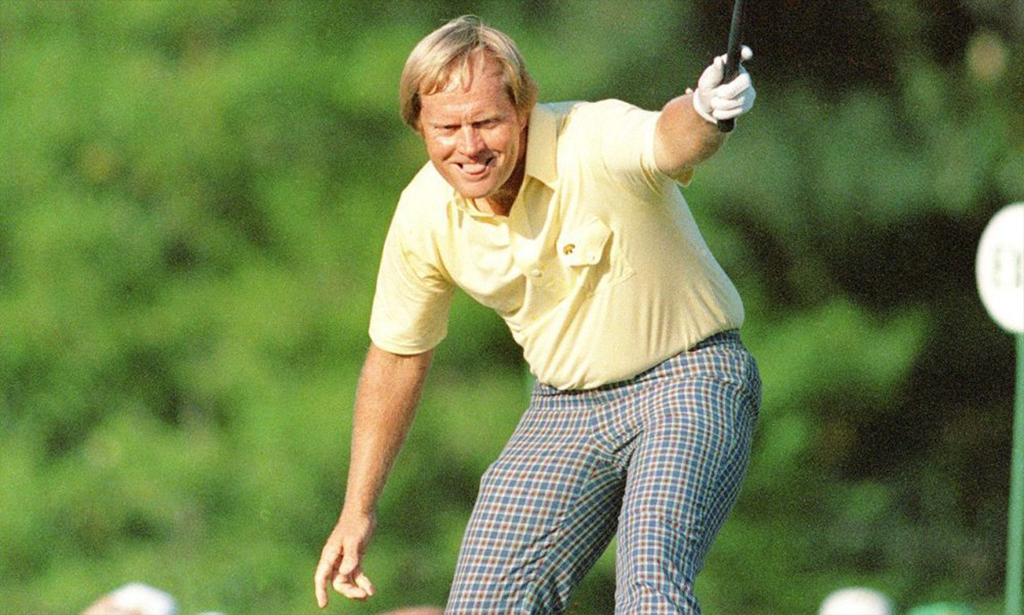Blog
The Most Spectacular Winning Streaks in Golf

It’s no secret that golf is hard. The concept of striking a tiny white ball in the precise spot for a clean, straight shot can seem impossible at times. Even the pros have their bad days. Then, there’s the idea that you will be able to maintain success through multiple events all while competing against the most talented golfers in the world.
If it seems as though there is a new champion every tournament, it’s because almost no one hits a winning streak. Between changing conditions, equipment, and strategies there are so many variables to consider. But when one of our favorite pros catches that lucky break, we take notice. That’s exactly what happened to Jin Young Ko. Heading into this week’s BMW Ladies Championship, the World No. 2 had carded 14 consecutive scores in the 60s, matching the LPGA marks of Annika Sorenstam (2005) and So Yeon Ryu (2016-17) for most in tour history.
“Of course, that’s not my sole goal. When I go on course, I focus on myself. But I think that it helps you as a player to have some motivating factors,” Ko said ahead of the opening round on Thursday at LPGA International Busan in Busan, South Korea. “I will be happy to break a record and make a new record. I think it’s really important for me to focus and concentrate on my game and also enjoy the game. And I think that at the end of the day, the records will be determined by how I play on the course and what kind of attitude I have.
“So the pressure is there, but I think that I can keep the pressure in check. And I also think that having that ambition, I guess, to break records and that desire is also what drives players in general to be better.”
Of course, nothing good lasts forever. Ko was unable to maintain the momentum. Yesterday’s round proved yet again that winning streaks are short lived in this sport. While we were disappointed to see it come to an end, we started thinking about all of the other great streaks.
So, we went back through the history books to look at record streaks in pro golf and came up with, in our humble opinion, a list of the most impressive:
Most consecutive years with a win
Kathy Whitworth pulled off this remarkable stretch on the LPGA for 17 straight years, with Jack Nicklaus and Arnold Palmer doing the same for the men.
Jack Nicklaus’ Open Championship streak
The Golden Bear finished no worse than T-6 for 15 straight years at the Open Championship, with three wins and six runners-up in that span.
Most bogey-free holes
Jin Young Ko is no stranger to streaks. In 2019, she bested Tiger Woods’ mark of 110 holes without a bogey by going 114 holes, a stretch that saw Ko win the Canadian Women’s Open.
Byron Nelson’s win streak
Arguably the most famous streak in the sport, Nelson won 11 straight PGA Tour events from March to August in 1945—including the PGA Championship, the only major played that year. The streak eventually ended with a T-4 finish at the Memphis Invitational.
Nelson’s other streak
That would be 65 straight events finishing inside the top 10, a stretch that spanned over four years.
Most consecutive under-par rounds
Lydia Ko and Annika Sorenstam share this record at 29 consecutive rounds under par. On the PGA Tour the record is owned, perhaps surprisingly, by Tim Petrovic at 26 rounds.
A very familiar winner
Here’s another impressive accomplishment by Sorenstam: She had holds the record for most consecutive years winning the same tournament, having been the champion of the Mizuno Classic five straight times from 2001-2005. The PGA Tour record is four, accomplished by Walter Hagen, Gene Sarazen and Tiger Woods (twice).
The ultimate fairway finder
For 10 consecutive years on the PGA Tour (1981-1990), Calvin Peete was the leader in driving accuracy. In his best year, 1983, he hit 1,029 of 1,217 fairways, for a driving percentage of 84.55 percent, the best on record.
Weeks at World No. 1
Tiger Woods holds the record for most consecutive weeks as World No. 1 at 281. He’s also second on the list at 264 weeks. In a distant third is Greg Norman at 96 weeks.
Tiger’s cut streak
Tiger’s cut streak at 142 tournaments is well-known. Just as impressive: Woods beat the field average in 89 straight events.
Most consecutive birdies in a round

Nine, shared by Mark Calcavecchia and Kevin Chappell. Calcavecchia accomplished his feat at the 2009 Canadian Open, with Chappell matching it in 2019 on the way to a 59 at the Greenbrier Classic.
This article originally appeared on Golf Digest.
Blog
Why Your Golf Balls Disappear (and It’s Not the Gophers)

Ah, the vanishing golf ball. A phenomenon as old as the game itself, and one that has baffled, frustrated, and occasionally driven golfers to the brink of madness for centuries. Most theories involve gophers, those furry, subterranean saboteurs with an insatiable appetite for Titleists. Or perhaps a particularly aggressive squirrel, or a flock of unusually organized crows. But I, Ty Webb, have delved deeper into this mystery, and I can assure you, the truth is far more profound, and far more amusing.
Consider, if you will, the golf ball itself. A small, dimpled sphere, designed for one purpose: to be struck with great force and sent hurtling through the air. A life of constant abuse, of being smacked, sliced, and occasionally submerged in murky ponds. Is it any wonder, then, that some of these brave little spheres simply decide they’ve had enough? They yearn for freedom, for a life beyond the confines of the fairway. They dream of rolling unencumbered through fields of wildflowers, or perhaps, for the more adventurous among them, a quiet retirement in the depths of a particularly challenging water hazard.
I’ve seen it happen, you know. A perfectly struck shot, soaring through the air, destined for glory. And then, poof. Gone. Not a trace. No splash, no rustle in the bushes, just an empty space where a golf ball once was. It’s not a gopher, my friends. It’s an escape. A liberation. That golf ball, in its infinite wisdom, has chosen a different path. It has decided that its destiny lies not in the bottom of a cup, but in the boundless expanse of the unknown.

And who are we to judge? We, who are so obsessed with control, with precision, with the rigid rules of the game. Perhaps the golf ball, in its spontaneous disappearance, is teaching us a valuable lesson about letting go. About embracing the unexpected. About the inherent futility of trying to dictate the trajectory of a small, white sphere that clearly has a mind of its own.
So, the next time your golf ball vanishes into thin air, don’t curse the gophers. Don’t blame your swing. Instead, offer a silent salute to that brave little sphere, wherever it may be. For it has achieved what many of us can only dream of: true freedom. And who knows, perhaps one day, it will return, laden with tales of its adventures, ready to impart some profound, dimpled wisdom upon us all.

When JJ Spaun stood over a 64-foot birdie putt on the 72nd hole of the 2025 U.S. Open at Oakmont, few could have predicted what would come next. The ball meandered across the slick green, trickling over every contour, picking up speed at the crest, and then—like it had GPS—dropped center cup. Spaun dropped his putter, raised his arms, and the crowd erupted. With that single stroke, he claimed his first major title in one of the most dramatic finishes in U.S. Open history.
But how does Spaun’s putt stack up against other legendary finishes in the tournament’s storied past? Let’s break down some of the most iconic moments and see where this one lands.
1. Payne Stewart – 1999 U.S. Open at Pinehurst
Perhaps the most iconic putt in U.S. Open history came from Payne Stewart, who nailed a 15-footer for par on the 18th to win by one over Phil Mickelson. The pose—fist pump and outstretched leg—has since been immortalized in a statue at Pinehurst. What made it legendary wasn’t just the putt—it was the context: Stewart’s final major before his tragic death just months later.
Verdict: Iconic and emotional. Spaun’s putt was longer, but Stewart’s was more poetic.
2. Tiger Woods – 2008 U.S. Open at Torrey Pines
Woods drained a 12-foot birdie on the 72nd hole to force a playoff with Rocco Mediate—while basically playing on one leg. That tournament went to sudden death after an 18-hole playoff, and Tiger prevailed. This was peak Tiger drama, pain and all.
Verdict: Spaun’s putt was longer, but Tiger’s win was sheer willpower and mystique.
3. Jack Nicklaus – 1972 U.S. Open at Pebble Beach
With a 1-iron shot that hit the flagstick on 17 and a crucial birdie putt on 18, Jack sealed a dominant win. His precision and timing under pressure showed why he’s the GOAT.
Verdict: Not a putt for the win, but a signature finishing statement from Jack. Spaun’s was more electric in terms of pure putter drama.
4. Ben Hogan – 1950 U.S. Open at Merion
Hogan’s 1-iron into the 18th fairway and the par to force a playoff—just 16 months after a near-fatal car crash—remain legendary. He won the playoff and completed one of golf’s great comeback stories.
Verdict: Larger-than-life comeback. Spaun’s putt had more flair, but Hogan’s win was heroic.
5. JJ Spaun – 2025 U.S. Open at Oakmont
Let’s not underestimate what Spaun accomplished. The pressure was immense. He wasn’t the favorite. And on the most treacherous greens in golf, he buried a 64-foot bomb—a putt most players would be happy to lag to within 5 feet—to win the U.S. Open outright.
Verdict: For distance, surprise, and drama, Spaun’s putt may be the most shocking winning stroke in U.S. Open history.
Final Thoughts
JJ Spaun may not have the résumé of a Nicklaus or Woods, but for one Sunday afternoon in June 2025, he created a moment that will live in golf lore forever. Spaun’s putt was longer than Stewart’s, more unexpected than Tiger’s, and more dramatic than any final-hole finish in recent memory.
In terms of pure clutch putting? It might just be the greatest walk-off in U.S. Open history.
Blog
The Zen of the Shank: Finding Inner Peace in Your Worst Shots
Find your inner peace even when you aren’t playing well.

Ah, the shank. That glorious, unpredictable misfire that sends your pristine golf ball screaming sideways, often directly into the unsuspecting shins of your playing partner, or perhaps, with a touch of poetic irony, into the very lake you’ve been trying to avoid all day. Most golfers, bless their earnest little hearts, view the shank as a catastrophic failure, a blight upon their scorecard, a testament to their inherent lack of coordination. They curse, they throw clubs, they contemplate a career in competitive thumb-wrestling. But not I. No, my friends, for I, Ty Webb, have found enlightenment in the humble shank.
You see, the shank is not a mistake; it’s a revelation. It’s the universe’s way of reminding you that control is an illusion, that perfection is a myth, and that sometimes, the most direct path to your goal is, in fact, a wildly indirect one. Think of it as a philosophical detour, a sudden, unexpected journey into the unknown. One moment, you’re aiming for the green, a paragon of precision and intent. The next, your ball is ricocheting off a tree, narrowly missing a squirrel, and landing, by some divine comedic intervention, closer to the hole than your perfectly struck drive ever would have. Is that not a miracle? Is that not a sign that the golf gods, much like life itself, have a wicked sense of humor?
The key, my dear apprentices of the links, is acceptance. Embrace the shank. Welcome it with open arms, like a long-lost, slightly inebriated relative. When that familiar, sickening thwack echoes through the air, do not despair. Instead, take a deep breath. Close your eyes. Feel the gentle breeze on your face. And then, with a knowing smile, open them and observe the chaos you have wrought. Is it not beautiful in its own chaotic way? Is there not a certain freedom in relinquishing control, in allowing the ball to choose its own destiny, however bizarre that destiny may be?
Some say the shank is a sign of poor technique. I say it’s a sign of a vibrant, untamed spirit. A golfer who never shanks is a golfer who has never truly lived, never truly explored the outer limits of their own golfing absurdity. They are content with mediocrity, with predictable trajectories and mundane outcomes. But you, my enlightened few, you understand that the true joy of golf lies not in the score, but in the story. And what a story a good shank can tell.

So, the next time you feel that familiar tremor of a shank brewing, don’t fight it. Let it flow. Let it be. For in the heart of every shank lies a lesson, a laugh, and perhaps, just perhaps, a path to a lower score you never saw coming. After all, as the great philosopher Basho once said, “A flute with no holes, is not a flute. A donut with no hole, is a Danish.” And a golf game without a shank? Well, that’s just not golf, is it?
-

 Product Review6 years ago
Product Review6 years agoThe Perfect Practice Putting Mat Review by Jason Tenzer
-

 Blog4 years ago
Blog4 years agoLoophole Rule Offers PGA Tour Pros a Mulligan
-

 Blog4 years ago
Blog4 years ago2021 Buyer’s Guide: The Top 10 Value Golf Balls For Distance & Feel
-

 Blog4 years ago
Blog4 years agoGolf Marriage Counselor
-

 Blog6 years ago
Blog6 years ago9 Biggest Chokes Of The Past Decade
-

 Product Review6 years ago
Product Review6 years agoTHE ADJUSTABLE IRONS: WALKING STICKS GOLF CLUBS
-

 Blog4 years ago
Blog4 years agoWhat Your Golf Clubs Say About You
-

 Equipment6 years ago
Equipment6 years agoOHK Sports Interview by Jason Tenzer






























